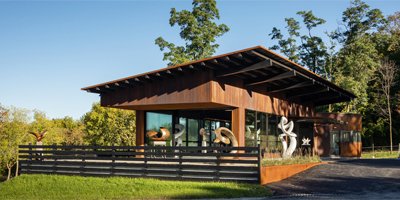Birdseye, an architect in Richmond, Virginia, has designed an artist studio for a stone carver in the Champlain Valley in Williston, Vermont, drawing inspiration from the client’s sculptural language and the existing structures on the horse farm site.
The studio is built on artist Richard Erdman’s residence, an 8.1 ha (20 acre) working horse farm. The plot includes multiple agricultural metal structures that function as stables, hay storage and equipment storage. The structure of the studio is defined by a cantilevered shed, clad in corrugated Corten steel panels, influenced by the existing metal-clad buildings on the farm. Structural steel members are exposed under the roof overhang and within the studio. A hydraulic loading door with a flush threshold provides rolling access to the main studio space. Inside the gate, a jib crane aids in the installation and removal of large-scale sculptures. Steel pedestals with wheels allow the sculptures to be easily moved and displayed.
The project site was established in the north-west corner of the paddock to serve as a bookend to the existing buildings and paddocks. A raised plinth elevates the building above rolling pastures, offering distant views of the Adirondack Mountains across the valley.
The landscape design takes cues from horse pastures. The plinth is held up by wooden railings that mimic the fence of the neighboring paddocks. The floor covering is compacted stone, extending to an infinity edge to the concrete walls to the south and west, and to a Corten steel edge to the east and north.
The interior spaces are minimal and open. A monumental display of steel shelving integrates into the composition of the space and the window. The interior wall and ceiling finishes are black to contrast with the marble sculptures. Custom full-scale metal pivot doors open to the office space and whitewashed library. A large custom wood cabinet offers mockup storage and display, and a polished concrete floor adds durability, functionality, and an overall minimalist aesthetic.
Ecological sensitivity is an important consideration in the project. The building is fully electric, renouncing any use of fossil fuels on site. Heating and cooling is provided by an electric heat pump system, and ventilation is provided by large operable doors and windows. Natural plaster and Swedish pine tar finishes contribute to healthy indoor air quality (IAQ). Abundant natural light is complemented by light emitting diode (LED) fixtures that are useful for sculptures. The permeable stone surface surrounding the building helps capture runoff and mitigate erosion across the site.

